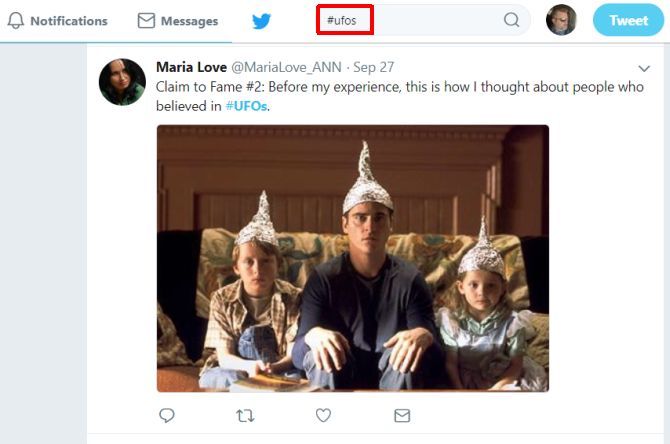
Building a large Twitter following isn’t something that happens overnight. But if you capitalize on human psychology, you can speed up that process a little.
Most people would deny that they are driven by psychological needs and desires, but the evidence proves otherwise.
In this article we explore some of the tactics you can use to entice people to follow you, and quickly boost your Twitter following.
1. Retweet Images With Strong Engagement
There is a lot of research out there showing that tweets with images get more engagement. Buffer conducted research that showed Twitter posts with images are retweeted 18 percent more often than those without.
Beyond just using images is how many people have already engaged with a post. When you retweet something that catches someone’s eye, they may consider following you if the post interests them.
On Psychology Today, Rob Henderson explains that to get people to act, you just need to convince them that other people are already taking action.
“Instead, we rely on signals like popularity. If everyone else is buying something, the reasoning goes, there is a good chance the item is worth our attention.”
You can capitalize on this by selecting things to retweet that already have high engagement numbers.
When people scroll down your timeline and see high engagement numbers at the bottom of these posts, it appears as though the engagement is with one of your own posts.
This gives the impression that a lot of people engage with your tweets and that you’re someone worth following. At the very least, it shows that you have your finger on the pulse of what’s popular.
2. Play on People’s Fear of Missing Out
When people are drawn to engage with your posts, they’re more likely to follow you for providing that positive experience. One of the best ways to entice that engagement is to trigger curiosity.
Marketers pay a lot of attention to what sparks a consumer’s curiosity enough so that they’ll try a new product. There are many ways to spark someone’s curiosity as they’re scrolling through their Twitter feed.
In his book The Psychology of Curiosity, psychologist George Loewenstein explains that there are five ways to induce “involuntary curiosity” in someone.
- Pose a question: When you pose an open question that challenges what people think they know, it triggers a curiosity response. People want to know if what they believe to be true is actually true. Loewenstein explains that this approach, “contronts the individual directly with missing information and is therefore perhaps the most straightforward curiosity inducer.”
- Guess an outcome: If you mention a news event in your post and comment on an expected outcome, it can entice people to follow you just to learn what happens. It can also entice people to follow you just to see how you react when you’re right or wrong.
- Violate expectations: If you really want to catch someone’s eye, post something that flies in the face of their expectations. Sharing new, shocking technology with followers suits this purpose well.
- Hint at hidden knowledge: If you’re an expert in a certain subject, craft your post in a way that suggests you have an important piece of information that people are missing. One tactic is saying a particular news article made you laugh. Loewenstein explains, “Watching someone chuckle as he or she reads a news article is likely to make one curious to see the article.”
- Bring up the past: Posting about something someone knew when they were younger, but might have forgotten, works well. This is more common on Facebook, but just as effective on Twitter. Loewenstein says, “Consider the enormous curiosity that is evoked by the recognition that one knew a piece of information but has forgotten it.”
Any of these tactics will trigger more engagement with your tweets. And when people engage with your posts, they’re more likely to follow you. Especially if you introduce them to something new or interesting.
3. Stay Positive
People are more likely to share or respond to positive tweets over negative one.
According to The Daily Dot, several studies conducted by scientists at the University of California and even Facebook confirmed that “positive emotions are more infectious than negative ones.”
This means that when someone sees a positive, funny post, they’re far more likely to like it and share it.
IT Help Desk Departments#Developer #node #nodejs #coding #js #angularjs #vuejs #reactjs #100DaysOfCode #webdev #coder #mysql #ruby #tech #javascript #html #react #php #womenwhocode #301DaysOfCode pic.twitter.com/uvM90x1vqE
— Dan Englishby (@DanEnglishby) September 28, 2018
Better yet, researchers found that such tweets even have a positive psychological effect that spreads outside of Twitter. This means, every positive tweet you send spreads happiness out into the world well beyond the internet.
4. Use Embedded Images
The Rise of Robotics and AI #AI #infographic #tech #MachineLearning #BigData #IoT #VR #DataScience #blockchain #ArtificialIntelligence #robotics #technology #data #DataAnalytics via @AnsonMcCade @athis_news @JackChurch_AI MT: @MikeQuindazzi #AI #IoT #BigData #infographics MT pic.twitter.com/xlcJ3lvJXy
— Harry Miller (@Harry_Robots) September 30, 2018
A common way people use Twitter is just to scroll through their feed. They scan for interesting information they can gather straight from the tweets.
This means that the more information you can provide to people without requiring them to click through, the more likely they’re going to see value in your tweet.
Infographics (how to make cool infographics with Piktochart) are a fantastic way to do this.
Another common approach is to embed video into tweets. Making your own videos for social networks isn’t too difficult either. It takes very little effort for someone to pause scrolling just to watch a quick video you’ve shared.
And if you pepper in somewhat of a positive message in there as well, you’re killing two birds with one stone.
Embedding images and videos with lots of information in a small space is an effective way to drive engagement.
5. Target People Like You
Business Insider highlighted a study by Theodore Newcomb, who found that people are most attracted to people who are similar to them.
In his research, Newcomb put subjects in a University of Michigan house to live together. He measured their stance on different controversial topics, and by the end of the study found that his subjects gravitated more toward housemates who shared their beliefs.
This seems like common sense, but it’s actually a very powerful tool on social media.
You can search social networks by hashtags that match the niche you post about, and identify the people there who hold the same position you do on different topics.
When you spot some tweets from anyone with an interest that matches yours, you can take any approach to attract their attention. This could be a reply or a retweet. It’s even better if the person has a large number of followers. You could potentially grab the attention of those followers as well, especially if the person replies to or likes your comment.
Almost every time you do this, you’ll get some kind of response. Sometimes the person will return the favor and promote you or your work.

6. Post How-Tos
Quicksprout has an interesting article looking into which kind of posts get the most retweets on Twitter. This determines that how-to style tweets received more than three times more retweets than any other type of text-based tweet.
The psychology behind this is fairly obvious. If you touch on a topic that fills in someone’s knowledge gap, you’re likely to see engagement.
Sourdough Bread – How it’s done
I’ve learnt myself, no training, just my own ‘technique’
I can guarantee my bread it’s a @RealBread #Soudough @HouseOfFeasts Bakery ? #HowTo pic.twitter.com/ptQp2JgDQa
— Damian Wawrzyniak (@ChefConsultant) September 26, 2018
And when you’ve offered someone something useful to learn, they’re more likely to follow you in hopes that you’ll likely offer more to learn in the future as well.
7. If All Else Fails, Resort to Flattery
One study by the Hong Kong University of Science and Technology revealed just how effective flattery is in advertising.
In the study, researchers showed different ads to student volunteers. Some of the ads flattered them, and others didn’t. Researchers found that the participants were more likely to use coupons offered by the brands that had complimented them.
This was true even though the students had, “discounted the value of the compliment because of its impersonal nature and the ulterior motive.”
The study revealed just how effective the psychology of flattery is. And this is just as true on Twitter as it is anywhere else.
These are really helpful tech resume tips from Jennifer Bland. https://t.co/C6Q9vfn9zQ
— Ryan Dube (@rdube) September 27, 2018
It’s easy to do this when you’re browsing Twitter hashtags on the topics you care about. Whenever you come across something great someone tweeted, just take a moment and offer a compliment. It’s something every one of us would appreciate, so why not do it for others?
Most of the time it will win you another follower. At the very least, it can land you a like and a retweet to all of their followers.
Growing Your Twitter Following
Without a doubt, at times it can feel like a lot of work to grow your number of followers on Twitter. But a carefully curated list of followers is far more useful than a high volume of random ones.
It means the people who follow you have followed you for good reasons. So remember to provide them with the valuable information and commentary they signed up for.
And if you’re just getting started on Twitter or you really don’t know where to begin, make sure to check out our definitive guide on how to use Twitter.
Read the full article: 7 Psychological Tricks to Build Your Twitter Following
from MakeUseOf https://ift.tt/2PoiyII
via IFTTT
0 comments:
Post a Comment